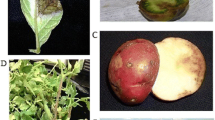Summary
Since the early 1980s and continuing through the end of the 20th century, potato late blight caused byPhytophthora infestans has become noticeably more problematic throughout the world. Exotic strains of the pathogen are largely responsible for the increased problems. The new strains were initially detected in Europe, but subsequently they have been detected in Asia, the Middle East, South America and North America. Populations in the Middle East and South America may represent secondary migrations from Europe. Several independent migrations have occurred such that migrant populations in North America are very different from those in Europe. Also, population structures ofP. infestans are different in different worldwide locations. In some locations the migrant strains are resistant to metalaxyl, but in other locations either migrant or indigenous strains may be resistant. In most locations, the migrant strains are more aggressive than the previous indigenous strains.
Similar content being viewed by others
References
Bourke, A., 1993. ‘The Visitation of God’? The potato and the great Irish famine. Dublin, Ireland., Lilliput Press, Ltd, Arbour Hill, 230 pp.
Day, J.P. & R.C. Shattock, 1997. Aggressiveness and other factors relating to displacement of populations ofPhytophthora infestans in England and Wales.European Journal of Plant Pathology 103:379–391.
Forbes, G.A., S.B. Goodwin, A. Drenth, P. Oyarzun, M.E. Ordonez & W.E. Fry, 1998. A global marker database forPhytophthora infestans.Plant Disease 82:811–818.
Fry, W.E. & S.B. Goodwin, 1997a. Re-emergence of potato and tomato late blight in the United States.Plant Disease 81:1349–1357.
Fry, W.E. & S.B. Goodwin, 1997b. Resurgence of the Irish Potato Famine Fungus.Bioscience 47:363–371.
Fry, W.E., S.B. Goodwin, A.T. Dyer, J.M. Matuszak, A. Drenth, P.W. Tooley, L.S. Sujkowski, Y.J. Koh, B.A. Cohen, L.J. Spielman, K.L. Deahl, D.A. Inglis & K.P. Sandlan, 1993. Historical and recent migrations ofPhytophthora infestans: chronology, pathways, and implications.Plant Disease 77:653–661.
Goodwin, S.B., B.A. Cohen & W.E. Fry, 1994. Panglobal distribution of a single clonal lineage of the Irish potato famine fungus.Proceedings of the National Academy of Science in the USA 91:11591–11595.
Goodwin, S.B., L.J. Spielman, J.M. Matuszak, S.N. Bergeron & W.E. Fry, 1992. Clonal diversity and genetic differentiation ofPhytophthora infestans populations in northern and central Mexico.Phytopathology 82:955–961.
Kamoun, S., P. van West, V.G.A.A. Vleeshouwers, K.E. de Groot & F. Govers, 1998. Resistance ofNicotiana benthamiana toPhytophthora infestans is mediated by the recognition of the elicitor protein INF1.Plant Cell 10:1413–1425.
Kato, M., E.S.G. Mizubuti, S.B. Goodwin & W.E. Fry, 1997. Sensitivity to protectant fungicides and pathogenic fitness of clonal lineages ofPhytophthora infestans in the United States.Phytopathology 87:973–978.
Lambert, D.H. & A.I. Currier, 1997. Differences in tuber rot development for North American clones ofPhytophthora infestans.American Potato Journal 74:39–43.
Miller, J.S., D.A. Johnson & P.B. Hamm, 1998. Aggressiveness of isolates ofPhytophthora infestans from the Columbia Basin of Washington and Oregon.Phytopathology 88:190–197.
Mizubuti, E.S.G. & W.E. Fry, 1998. Temperature effects on developmental stages of isolates of three clonal lineages ofPhytophthora infestans.Phytopathology 88:837–843.
Smart, C.D., M.R. Willmann, H. Mayton, E.S.G. Mizubuti, R.W. Sandrock, A.E. Muldoon & W.E. Fry, 1998. Self-fertility in two clonal lineages ofPhytophthora infestans.Fungal Genetics and Biology 25:134–142.
Stevens, N.E., 1933. The dark ages in plant pathology in America: 1730–1870.Journal of the Washington Academy of Sciences 23:435–446.
Author information
Authors and Affiliations
Rights and permissions
About this article
Cite this article
Fry, W.E., Smart, C.D. The return ofPhytophthora infestans, a potato pathogen that just won't quit. Potato Res 42, 279–282 (1999). https://doi.org/10.1007/BF02357858
Issue Date:
DOI: https://doi.org/10.1007/BF02357858




